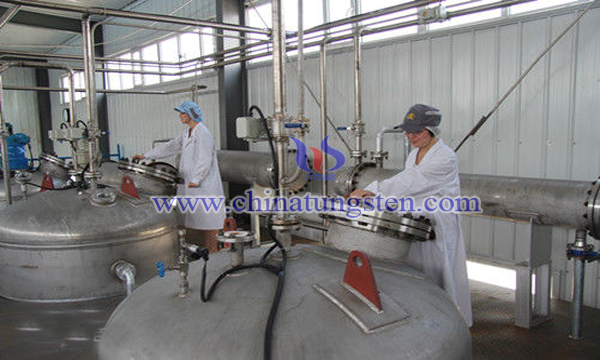Ammonia Nitrogen Recycling by Tungsten Smelting and Extraction Method
- Details
- Category: Tungsten Information
- Published on Sunday, 17 June 2018 16:20
In tungsten smelting, ammonium chloride is recycled by evaporation crystallization, and ammonia nitrogen is recycled. The existing technology has low ammonia nitrogen recovery rate and high energy consumption of evaporation crystallization. Low recycling rate will cause poor working environment and waste water difficult to reach standard discharge. At the same time, the cost of evaporation recycling will also be higher and higher. Therefore, it is of great significance to develop a low energy recovery process to replace the current evaporation crystallization process.

Some scholars have provided a method of using extraction and absorption in the treatment of ammonia nitrogen in tungsten smelting, in order to further improve the recycling rate of ammonia nitrogen, improve the working environment and reduce production costs. The following steps are as follows:
(1) The evaporated ammonia water is added to the organic phase extractant to extract the ammonium ion NH4+. The organic phase extractant is made up of 80% kerosene and 20% P507 according to the mass percentage. The free water and hydroxyl ions in the ammonia water are entered into the aqueous phase of the extracted liquid, thus the separation of the ammonium ions from the hydrogen and oxygen ions and the discharge of free water are achieved. The remaining liquid is clean process water to achieve harmless discharge.
(2) The organic phase after extraction is extracted with industrial concentrated hydrochloric acid, and the heavy phase after stripping is ammonium chloride, the concentration of chlorine root is 175 ~ 200g/L, the layer is at the bottom, and the bottom discharge valve is removed. The light phase P507 organic phase is used for the next cycle after washing, and the ammonium chloride solution of the stripping solution is absorbed and absorbed after the absorption of the mixture. The concentration of medium chlorine is 175 ~ 200g/L; the ammonia concentration 110g/L returns tungsten smelting from the exchange process as analytical agent.
(3) The organic phase after stripping is washed by adding 0.5% organic phase volume without salt water to ensure that the residual ammonium chloride in the organic phase is discharged as much as possible so as not to affect the operation of the next cycle, and to reduce the amount of ammonium chloride into the water phase in the next cycle and to pollute the process water. The washing solution is ammonium chloride solution, together with the previous stripping solution (ammonium chloride solution) to enter the ammonia absorption. After washing, the organic phase extractant P507 is recycled into the next cycle.
This method combines the different requirements of ammonia nitrogen in tungsten smelting, a certain concentration of ammonia water (NH3•H2O), combined with a certain concentration of ammonium chloride (NH4Cl) as an analytical agent in the application of tungsten smelting ion exchange. The ammonium ion in the ammonia water produced by the tungsten smelting process is extracted and recycled by the combination of extraction and absorption. The ammonia liquid produced by a certain concentration of ammonium chloride is absorbed effectively by reverse extraction. Finally, a certain concentration of ammonium chloride and ammonia mixture, which meets the requirements of the process, can be obtained as an analytical agent to obtain ammonia. Nitrogen is used in the process of closed-circuit recycling, thereby reducing costs, saving resources and protecting the environment.
- Tungsten Manufacturer & Supplier, Chinatungsten Online: www.chinatungsten.com
- Tungsten News & Prices of China Tungsten Industry Association: www.ctia.com.cn
- Molybdenum News & Price: news.molybdenum.com.cn
- Tel.: 86 592 5129696; Fax: 86 592 5129797; Email: sales@chinatungsten.com



 sales@chinatungsten.com
sales@chinatungsten.com